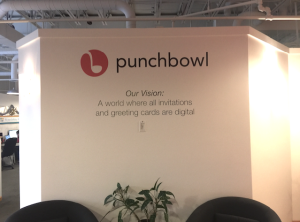This is the story of how a BHAG transformed my company. If you read the whole post, I believe it may transform how you view your business or work too. Oh, and you’ll also learn what the letters BHAG stand for. First, a story…
Once upon a time (a couple of years ago), my company Punchbowl made the decision to launch some marketing campaigns on Pinterest. The ability to buy ‘sponsored pins’ was new on Pinterest, and their marketing platform was fairly rudimentary. We saw an opportunity to accelerate customer acquisition, and spent some time evaluating how to scale our marketing on Pinterest. We quickly realized that the reporting functionality on Pinterest would not suit our needs, so I asked our engineering team to build some automation tools. A few weeks later, we had some powerful new ways to look at the data. During the same period of time, I spoke with a number of CEO’s about their Pinterest marketing plan, and heard a similar story: they saw opportunity, but the marketing platform was lacking. Hmm, I smelled opportunity.
About a month later, I held a Punchbowl Board meeting, and presented what I had learned. I explained to the Board that I thought there were several other companies that could benefit from the automation tools we had already built and we might be able to capitalize. I suggested to the Board that we should spend some time to explore the market and to productize what we had already built. In short, I was suggesting a radical pivot from the business we’ve built at Punchbowl.
As soon as I presented the opportunity, one of our Board members immediately started asking me a series of questions: He asked me, “What’s the long-term vision for the company?” and “Why does what you’ve built matter to the world?” and “Why is your team uniquely equipped to succeed on your vision?”
Simple questions, yes — but I didn’t have ready answers. At the core, this Board member was challenging me to explain ‘what is the REASON you do what you do?’ He was not asking me to explain how I was going to return capital to our shareholders, or why it matters that I’ve created jobs, or my personal motives for starting a company. He wanted to know why it matters. How many of my readers can quickly answer these kinds of questions for your own line of work? You may be able to explain WHAT you do, but can you quickly articulate WHY IT MATTERS?
I left that Board meeting somewhat embarrassed that I didn’t have easy answers to these uncomplicated questions. I knew that I’m an entrepreneur at heart and that I wanted to build a successful company. The truth is that I had spent most of my time in the early days pondering how to survive or how to achieve the next milestone. No one had asked me these kinds of questions, and I didn’t think to ask them on my own. I had some existential thinking to do.
I spent the next few weeks thinking about Punchbowl’s vision. The first thing I did was to seek out some books and articles to read. I devoured articles online, and skimmed several books. One book in particular resonated with my dilemma. The book is called Built to Last: Successful Habits of Visionary Companies by Jim Collins and Jerry Porras. It’s the predecessor of the book Good to Great, another best-seller. The book “Built to Last” showed how great companies triumph over time and how long-term sustained performance can be engineered into the DNA of an enterprise from the very beginning. The book coins the phrase BHAG, a “big, hairy, audacious goal.” Wikipedia correctly defines a BHAG as “a strategic business statement similar to a vision statement which is created to focus an organization on a single medium-long term organization-wide goal which is audacious, likely to be externally questionable, but not internally regarded as impossible.” Just like that, I had found the inspiration to answer the questions that had been eluding me.
Let’s fast-forward six months: as I went through this process, I came up with a methodology to articulate my company’s BHAG. And I think it can work for others too. Here are 3 steps to articulate your BHAG
Step 1: Answer Four Questions. The first step in developing a BHAG is step back and take the time to thoroughly answer the following questions:
1) Why does this company/business exist?
This question will challenge you right from the start. Beyond profits and jobs, what’s the point of your business? How does what you do fit into the narrative of history? Why does the company exist at this moment in time? The world has been around for a very long time, and your career only lasts for about 50 years. So what’s the unique reason your company exists?
2) What good does this company do in the world?
What is the difference the company will make in the world? How do you help people or the planet? Take money out of the equation for a moment: how does your company impact society in a positive way?
3) What will be the legacy of the business?
I love this question, because it forces you to think about the impact your company will have over the really long-term. The word legacy means “something handed down from the past, as from an ancestor or predecessor.” In the business context, it’s a fascinating question to ponder. What impact did your company have 50 years from now? Does it exist only for a moment in time or are there lasting impacts?
4) What do I personally bring as its leader?
This question asks simply “why you?” What characteristics about you make YOU the right person to lead this business? What do you bring to the table? Why can’t someone else do what you’re doing?
Step 2: Ask Your Team. As I began to try to answer these questions for myself, I asked a few of my key team members to arti culate our vision. I emailed them just the first question “Why does this company exist?” and asked them to send me an email back. I chose a handful of people within the company so I would get perspectives from Marketing, Engineering, and Finance. Then I took them out of the office on an off-site to get perspective. As you can see in the picture, I took a few of my team members sailing in Boston Harbor and we spoke about vision and legacy as we watched the ocean waves. That certainly gave us perspective.
culate our vision. I emailed them just the first question “Why does this company exist?” and asked them to send me an email back. I chose a handful of people within the company so I would get perspectives from Marketing, Engineering, and Finance. Then I took them out of the office on an off-site to get perspective. As you can see in the picture, I took a few of my team members sailing in Boston Harbor and we spoke about vision and legacy as we watched the ocean waves. That certainly gave us perspective.
Step 3: Find Inspiration. I’m a firm believer in drawing inspiration from those around you. So I looked for other organizations that had articulated their BHAG with an emphasis on companies that had visions that might be “externally questionable, but not internally regarded as impossible.” I searched online and found several examples that were inspirational:
• Google: To organize the world’s information and make it universally accessible and useful
• Facebook: To give people the power to share and make the world more open and connected
• Susan G. Koman Foundation: A world without breast cancer
• Space X: Enable human exploration and settlement of Mars
I used the above steps to define the BHAG for Punchbowl, and I’m surprised at the impact it’s had on our company. I won’t go into the details of how we arrived at our BHAG in this post, but I’ll share with you what now adorns the wall as you walk into our office:

Once we established our vision and shared it with the rest of team, I noticed several immediate benefits:
• CLARITY: Our BHAG offers unambiguous direction for the business. It solidifies who we are as a company and drives decision-making. We no longer debate certain topics, our long-term BHAG gives us clarity. It is now much easier to say no to opportunities or partnerships even if they appear to be lucrative. We know who we are, what we stand for, and what we are trying to achieve.
• UNIFICATION: Our BHAG helps connect every single employee to the company’s reason for existence, and guides all of us to make decisions that will support that vision. It helps employees understand the underlying reason for certain decisions, and gets everyone excited about working as a team toward a common goal. As Collins and Porras wrote, “A true BHAG is clear and compelling, serves as unifying focal point of effort, and acts as a clear catalyst for team spirit. It has a clear finish line, so the organization can know when it has achieved the goal; people like to shoot for finish lines.”
• PURPOSE: With a clear BHAG, you may uncover other ways to support your long-term vision. Most people want to work for a company that stands for something and empowers them to do the best they can because they’re working for something bigger than themselves. For Punchbowl, that took the form of a new non-profit (Punchbowl.org Environmental Fund, Inc., an independent, nonprofit 501(c)(3) organization) that aims to eliminate unnecessary and wasteful paper production. We donate a portion of our profits to the non-profit and we communicate our environmental message throughout Punchbowl.com. We’re proud of the key message and impact our new charity will have on the environment. Remember, even if your impact is small, you can make a difference.
FINAL THOUGHTS: My now infamous meeting with the Punchbowl Board of Directors was almost two years ago, but the impact it’s had on the business has been remarkable. Looking back, I wish I had defined a BHAG much, much earlier in my startup journey as it would have helped me with many decisions along the way. Look — I know there is never a good time to stop what you’re doing and gain a larger perspective. The process to define a BHAG is time-consuming and will be some of the hardest work you’ll ever tackle. But I can tell you unequivocally that the process is worth it and will transform the way you think about your work forever. It certainly did for me and my team.


